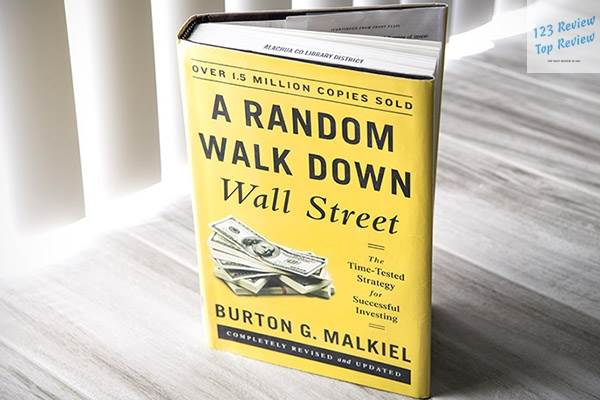Over the years, A Random Walk Down Wall book has guided countless investors, from novices to professionals, offering a deep understanding of market behavior and the principles that underpin successful investing. Malkiel’s work challenges many traditional notions about stock picking and market timing, advocating instead for strategies rooted in modern financial theory, particularly the Efficient Market Hypothesis (EMH).

In this article, 123 Review explores the key concepts, investment strategies, analysis techniques, historical context, risk management, common investing mistakes, performance evaluation, practical advice, and the overarching investment philosophy presented in Malkiel’s book.
Key Concepts and Theories
Efficient Market Hypothesis
The Efficient Market Hypothesis (EMH) is the cornerstone of Malkiel’s thesis. According to EMH, financial markets are “informationally efficient,” meaning that prices of securities reflect all available information at any given moment. This concept suggests that it is nearly impossible for investors to consistently achieve returns that outperform the market averages through either stock picking or market timing because any new information is quickly absorbed into asset prices. Malkiel’s endorsement of EMH underscores his belief that the stock market follows a “random walk,” where price changes are unpredictable and follow no discernible pattern, thus making it futile to try to outguess the market.
Firm Foundation Theory
The Firm Foundation Theory posits that every investment has an intrinsic value based on its future expected cash flows, which can be estimated through careful analysis. According to this theory, rational investors should buy assets that are priced below their intrinsic value and sell them when the market price exceeds this intrinsic value. Malkiel explains that this theory supports a disciplined, long-term approach to investing, where the focus is on the fundamental strength and future earning potential of assets, rather than short-term market movements.
Castle in the Sky Theory
In contrast to the Firm Foundation Theory, the Castle in the Sky Theory is grounded in speculation. It suggests that the value of an asset is not tied to any fundamental analysis but rather to what investors believe others will pay for it in the future. This theory often leads to speculative bubbles, where asset prices rise far above their intrinsic value, driven by the belief that prices will continue to increase. Malkiel warns that this speculative approach is dangerous and unsustainable, often leading to market crashes when the “castles in the sky” inevitably collapse.
Investment Strategies
Index Fund Investment Strategy
Malkiel is a strong proponent of the index fund investment strategy. Index funds are designed to replicate the performance of a specific market index, such as the S&P 500, by holding all (or a representative sample) of the securities in that index. This strategy aligns with the Efficient Market Hypothesis because it eliminates the need for active management and the associated costs. Malkiel argues that, over the long term, index funds typically outperform actively managed funds, due in large part to their lower fees and the challenge of consistently beating the market. The simplicity, diversification, and cost-effectiveness of index funds make them an ideal choice for most investors.
Dollar-Cost Averaging
Dollar-cost averaging is an investment strategy that involves regularly investing a fixed amount of money into a portfolio, regardless of market conditions. This approach helps mitigate the impact of market volatility by purchasing more shares when prices are low and fewer shares when prices are high. Over time, this strategy can lead to a lower average cost per share and reduce the risk associated with trying to time the market. Malkiel advocates for dollar-cost averaging as a disciplined and straightforward way to build wealth steadily, emphasizing its benefits for long-term investors who wish to avoid the emotional pitfalls of market timing.
Importance of Diversification
Diversification is a fundamental principle of Malkiel’s investment philosophy. By spreading investments across a wide range of asset classes, sectors, and geographies, investors can reduce their exposure to the risks associated with any single investment. Diversification ensures that poor performance in one area does not disproportionately affect the overall portfolio, allowing investors to capture market returns while managing risk. Malkiel underscores that diversification is essential for creating a resilient portfolio that can weather various market conditions, providing a smoother ride toward financial goals.
Analysis Techniques
Fundamental Analysis
Fundamental analysis involves evaluating a company’s financial health, industry position, and broader economic factors to estimate its intrinsic value. This analysis typically includes examining financial statements, assessing management quality, and understanding the competitive landscape. While Malkiel acknowledges the value of fundamental analysis for assessing individual companies, he cautions that, due to the efficiency of markets, it is challenging to consistently outperform the market through this method alone. Despite this, understanding the fundamentals remains crucial for long-term investors, particularly when selecting assets for a diversified portfolio.
Technical Analysis
Technical analysis, on the other hand, focuses on historical price patterns, trading volumes, and other market data to predict future price movements. Proponents of technical analysis believe that past market behavior can provide insights into future trends. However, Malkiel is highly skeptical of this approach. He argues that price movements are too random and influenced by unpredictable factors to be consistently forecasted using charts and patterns. As a result, he considers technical analysis to be largely ineffective for long-term investment success, instead favoring strategies that are grounded in broader market principles.
Behavioral Finance Insights
Malkiel also delves into behavioral finance, a field that examines how psychological factors influence investor behavior and market outcomes. Behavioral finance challenges the traditional notion of the “rational investor” by highlighting common biases, such as overconfidence, loss aversion, and herd behavior. Malkiel explains how these biases can lead to irrational decisions, such as chasing hot stocks or panicking during market downturns. Understanding these psychological tendencies is critical for investors who wish to avoid common pitfalls and make more rational, objective decisions that align with their long-term goals.
Historical Context
Major Market Crashes
Malkiel’s book provides a detailed examination of major market crashes, including the 1929 Great Depression, the 1987 Black Monday, and the 2008 Financial Crisis. Each of these events is analyzed to demonstrate how speculative bubbles, driven by irrational investor behavior, eventually burst, leading to widespread financial turmoil. Malkiel uses these examples to reinforce the importance of a disciplined, long-term investment strategy that can withstand market volatility and avoid the dangers of speculative excess.
Financial Bubbles
In addition to market crashes, Malkiel discusses various financial bubbles, such as the Tulip Mania of the 1600s and the Dot-com Bubble of the late 1990s. These episodes illustrate the dangers of the Castle in the Sky Theory, where asset prices become detached from their underlying value due to excessive speculation. Malkiel warns that these bubbles are often fueled by a combination of greed, herd mentality, and the belief that “this time is different.” By recognizing the signs of a bubble, investors can avoid getting caught up in the hype and protect their portfolios from significant losses when the bubble eventually bursts.
Evolution of Investment Strategies
Over the decades, investment strategies have evolved significantly, shifting from speculative stock-picking to more evidence-based approaches. Malkiel’s work has been instrumental in this evolution, promoting strategies that emphasize long-term growth, risk management, and the principles of market efficiency. His advocacy for index funds and passive investing has had a profound impact on the investment landscape, leading to the widespread adoption of these strategies among both individual and institutional investors.
Risk Management
Understanding Investment Risks
Risk is an inherent part of investing, and Malkiel emphasizes the importance of understanding the various types of investment risks. These include market risk (the risk of losses due to market fluctuations), interest rate risk (the risk of changes in interest rates affecting the value of bonds), and inflation risk (the risk that inflation will erode purchasing power). By recognizing these risks, investors can make informed decisions and tailor their investment strategies to align with their financial objectives and risk tolerance. Malkiel also stresses that risk cannot be entirely eliminated, but it can be managed effectively through diversification and disciplined portfolio management.
Portfolio Allocation Principles
Effective portfolio allocation is a key component of risk management. Malkiel suggests that asset allocation should be based on an investor’s age, risk tolerance, financial goals, and time horizon. For example, younger investors with a longer time horizon may allocate a larger portion of their portfolio to equities, which offer higher potential returns but also come with higher risk. As investors approach retirement, they might shift more of their assets into bonds, which provide greater stability and income. Malkiel emphasizes that a well-balanced portfolio, tailored to individual circumstances, is crucial for achieving financial goals while managing risk.
Importance of Risk Tolerance
Understanding and respecting one’s risk tolerance is essential for long-term investment success. Risk tolerance refers to the degree of variability in investment returns that an investor is willing to endure. Malkiel advises that investors should assess their comfort level with market volatility and potential losses before selecting an investment strategy. Those with low risk tolerance may prefer more conservative investments, while those with higher risk tolerance might opt for more aggressive strategies. By aligning their portfolio with their risk tolerance, investors can maintain discipline during market downturns and avoid making emotionally driven decisions that could derail their financial plans.
Common Mistakes in Investing
Avoiding Herd Mentality
One of the most common mistakes in investing is following the herd. Herd mentality occurs when investors make decisions based on the actions of others rather than on their own analysis or strategy. This behavior often leads to buying high during market manias and selling low during panics—exactly the opposite of what successful investors should do. Malkiel warns that succumbing to herd mentality can be detrimental to long-term financial health. Instead, he encourages investors to remain focused on their own financial goals and to resist the temptation to follow the crowd, especially during times of market exuberance or fear.
Overtrading Issues
Overtrading, or the excessive buying and selling of assets, is another common pitfall that Malkiel cautions against. Frequent trading can erode investment returns due to transaction costs, taxes, and the potential for poor timing. Malkiel’s research shows that a more passive approach, characterized by long-term holding periods and minimal trading, tends to yield better results over time. He advises investors to avoid the urge to tinker with their portfolios too frequently and to adopt a more hands-off strategy that allows their investments to grow over the long term.
Emotional Influences on Investment Decisions
Emotions play a significant role in investment decisions, often to the detriment of investors. Fear and greed are the two most powerful emotions that can drive irrational behavior in the markets. Fear can lead to panic selling during market downturns, locking in losses, while greed can result in overbuying during market booms, increasing exposure to risk. Malkiel emphasizes the importance of emotional discipline, advising investors to stick to their long-term strategy regardless of short-term market fluctuations. By keeping emotions in check and maintaining a rational approach, investors can avoid the costly mistakes that often arise from emotional decision-making.
Performance Evaluation
Comparing Index Funds vs. Actively Managed Funds
A key argument in Malkiel’s book is the comparison between index funds and actively managed funds. Over the long term, index funds tend to outperform actively managed funds. This outperformance is largely due to the lower fees associated with index funds and the difficulty of consistently beating the market through active management. Actively managed funds incur higher costs due to research, trading, and management fees, which can significantly reduce net returns. Malkiel’s analysis shows that, when these costs are taken into account, even the most skilled fund managers struggle to consistently outperform their benchmark indexes, making index funds a superior choice for most investors.
Long-Term Investment Performance
Malkiel underscores the importance of adopting a long-term perspective in investing. Historical data consistently shows that, despite short-term volatility, the stock market has delivered positive returns over extended periods. By staying invested through market cycles and resisting the urge to time the market, investors can benefit from the compounding of returns over time. Malkiel’s emphasis on long-term investment performance aligns with his advocacy for passive strategies, such as index fund investing, which allow investors to capture the market’s overall growth without being derailed by short-term market noise.
Costs of Trading and Fund Management
The costs associated with trading and fund management can have a significant impact on investment returns. Malkiel highlights the hidden costs of frequent trading, including transaction fees, bid-ask spreads, and capital gains taxes, which can erode returns over time. Additionally, actively managed funds typically charge higher management fees, which further reduce net returns. Malkiel argues that by minimizing these costs through the use of low-cost index funds and a buy-and-hold strategy, investors can keep more of their money working for them, ultimately leading to better long-term outcomes.
Practical Advice for Investors
Building a Balanced Portfolio
One of Malkiel’s key pieces of advice for investors is the importance of building a balanced portfolio. A balanced portfolio includes a mix of asset classes, such as stocks, bonds, and real estate, tailored to the investor’s goals, risk tolerance, and time horizon. This approach provides diversification, reducing the overall risk of the portfolio while allowing for potential growth. Malkiel advises that a well-diversified portfolio is essential for navigating the ups and downs of the market and achieving long-term financial success.
Strategies for Young Investors
Malkiel offers specific guidance for young investors, who have the advantage of a long investment horizon. He suggests that young investors should allocate a larger portion of their portfolio to equities, which, despite their higher volatility, offer greater potential for long-term growth. By starting early and investing consistently, young investors can take advantage of the power of compounding, allowing even small contributions to grow significantly over time. Malkiel also encourages young investors to adopt a disciplined, passive investment strategy, such as dollar-cost averaging into index funds, to build wealth steadily and avoid the pitfalls of trying to time the market.
Retirement Planning Techniques
Retirement planning is another area where Malkiel provides valuable advice. He recommends that as investors approach retirement, they should gradually shift their portfolio allocation from equities to bonds. This shift reduces the portfolio’s volatility and provides a more stable income stream, which is crucial for retirees who rely on their investments to fund their living expenses. Malkiel also emphasizes the importance of maintaining a diversified portfolio in retirement, balancing the need for growth with the need for income and capital preservation.
Conclusion on Investment Philosophy
Final Thoughts on Market Theory
Malkiel’s A Random Walk Down Wall Street offers a compelling case for the Efficient Market Hypothesis and the benefits of passive investing. His analysis demonstrates that financial markets are highly efficient, making it exceedingly difficult for individual investors to consistently outperform the market through active management. By embracing market theory and focusing on strategies that are supported by empirical evidence, investors can improve their chances of achieving their financial goals.
Recommendations for Individual Investors
For individual investors, Malkiel’s recommendations are clear: adopt a passive investment strategy, prioritize diversification, and maintain a long-term perspective. He advises against the allure of stock-picking and market timing, emphasizing instead the value of low-cost index funds, dollar-cost averaging, and disciplined risk management. By following these principles, individual investors can build a resilient portfolio that is well-positioned to grow over time.
Lasting Lessons from Malkiel’s Work
The lasting lessons from A Random Walk Down Wall Street are rooted in the importance of discipline, patience, and rationality in investing. Malkiel’s work teaches that success in the stock market is not about outsmarting others or predicting the next big trend but about adhering to proven strategies that minimize risk and maximize long-term returns. His emphasis on efficient markets, the dangers of speculation, and the value of a diversified portfolio remains as relevant today as it was when the book was first published. In summary, A Random Walk Down Wall Street continues to offer timeless wisdom for investors seeking to build wealth while managing risk. Malkiel’s advocacy for passive investing, market efficiency, and a disciplined approach has influenced generations of investors and remains a guiding light for anyone navigating the complexities of the financial markets.





